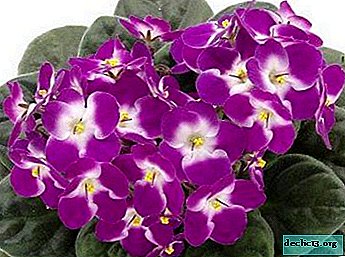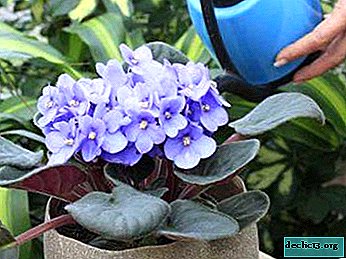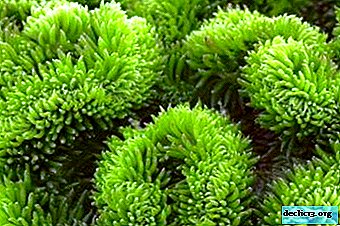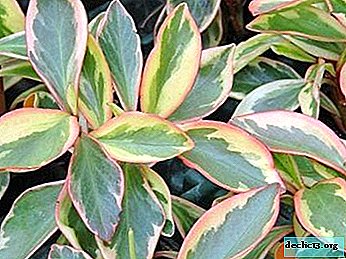Beauty on the windowsill: growing and caring for violets at home

Violet is a popular houseplant that won the hearts of many flower growers with its bright and lush flowering.
A violet has long appeared among garden crops, and now it is diligently grown in room conditions. Its inflorescences attract with its beauty, and the leaves are velvety
Today, there are many types of it, each of which differs not only in external characteristics, but also in the features of care. Knowing all the intricacies of growing violets, you can prevent the development of diseases and prolong flowering.
How to care at home?
Choosing the right pot
When growing a violet at home, it is important to take care of the right choice of pot. In order for the earthen lump to not sour, it must be moisture- and breathable. This will allow the root system to actively develop. For an adult flower, a container whose height and diameter is 10 cm is suitable.
Moreover, the lower part of it ½ should consist of drainage. Until the root system fills the pot with the substrate, rooting will not occur. For breeding, the first pot in diameter will be 6 cm. But the drainage hole should be large. Plant transplantation occurs every 3 years. At the same time, it is not necessary to change the capacity each time, it is important to change the substrate, clean the roots.
The composition of the soil and its proportions
When caring for a room violet, it is important to take care of a quality substrate. For planting, use an acidic composition, it includes such ingredients:
- peat;
- dried sphagnum moss;
- sheet earth;
- charcoal.
Moss and coal should not exceed 10% of the total composition of the main components:
- peat - 3 parts;
- sheet land - 5 parts;
- large river sand - 1 part.
Necessary humidity
 In the natural habitat, violets are used to high humidity. At home, maintain humidity in the range of 50-60%, not less. If the humidity level decreases, the amount of moisture absorbed by the flower will not compensate for the amount of water evaporated by the violet.
In the natural habitat, violets are used to high humidity. At home, maintain humidity in the range of 50-60%, not less. If the humidity level decreases, the amount of moisture absorbed by the flower will not compensate for the amount of water evaporated by the violet.
As a result, the buds will not fully open, and the leaves will begin to dry and curl. To increase the humidity level, it is not recommended to spray the plant from the spray gun. This will only aggravate the situation, as it will lead to the development of fungal diseases. But you can increase humidity without damaging the flower if you collect several pots in a group. Just make sure that leaves from different pots do not touch each other.
Lighting features and choosing the right location
As soon as the plant is in a new environment, it is instantly stressed. In order for the adaptation period to pass as quickly and easily as possible, it is necessary to provide the violet with ideal conditions. For this flower containers should be placed on a window that faces west or east.
If you install the container on the south window, you have to shade the plant. And although the violet responds positively to sunlight, with its intense influence and its location on the south side, this is dangerous by the development of burns on the delicate velvety leaves. Because of this, unattractive holes with dry edges form on them. A mosquito net should be located on the window so that the sun's rays are scattered.
And then it will be possible to avoid the negative impact.
Important. When placing the plant on the windowsill, make sure that the leaves do not touch the glass. Fresh air for violets is also useful, but there should not be any drafts, since this is a real stress for the plant. To ensure that all parts and sides of the violet bush receive an equal amount of light, rotate the pot regularly.Do this once a week or during watering. If this is not done, then the bush will stretch in one direction, resulting in a difference in the size of leaves and flowers.
Temperature mode
The buds open at a temperature of 18 degrees (in winter) and 24 degrees (in summer). If the temperature is below or above the specified range, then the growth and flowering of violets stops.
How to water?
It is necessary to water the violet so that the soil in which it is located does not dry out and does not turn into a hard lump. Moisturize 2-3 times a week. The frequency of watering is determined taking into account the humidity in the room, season and soil. And although the violet loves moist soil, waterlogging is not permissible.
Water at room temperature. It should be soft and settled. At the same time, make sure that water does not fall on the leaves. When watering, you should adhere to the following rules:
 Choose a method of humidification: regular, pallet or wick. We consider the latter option the most optimal. If you configure the system correctly, then you can moisten the violet every 2 weeks.
Choose a method of humidification: regular, pallet or wick. We consider the latter option the most optimal. If you configure the system correctly, then you can moisten the violet every 2 weeks.- When wick watering, capillary properties of the cord are used, due to which water from the tank under the pot rises along the wick and gives moisture to the soil. Thus, a houseplant receives the amount of fluid that it needs at a given time and under given conditions.
- Pour water out of the pan after 15 minutes.
- Use filtered fluid only.
- Its temperature should be 18-22 degrees.
Fertilizers
To prevent the death of a houseplant, you need to know when it needs top dressing, and when to refuse it. For the full growth and flowering of violets, the following compositions are required:
- Mineral fertilizers. These include superphosphates, due to which flowering and active growth are ensured. To apply colorless or whitish granules is necessary during transplantation.
- Complex mineral fertilizers. Thanks to them, the indoor flower is saturated with important mineral compounds.
- Organic composition. For fertilizer, you can use a small amount of humus or humus, which should be applied during transplantation. Feeding is necessary only for adults and healthy individuals.
For more information about why violets may not bloom and how to properly care for a plant in order to avoid this, we talked in a separate article.
Uzambar plant variety and its differences from the usual room
Compared to ordinary indoor violets, the Saintpaulia (Uzambara violet) has a corolla consisting of 5 petals. It has an almost regular shape and is soldered into a tube. The number of stamens is not 5, but 4, due to which the winter-cliffiness of the flower, which is so pronounced in ordinary violets, is invisible.
There are differences in terms of care. Uzambara violet requires heat, humidity, drafts are not permissible for it, it is demanding on soil and lighting quality.
Growing, propagating and transplanting
If indoor violet regularly receives nutrients in the form of liquid fertilizers, then a transplant is not necessary. Do this only if the plant is very crowded in the pot, it is penetrated by the roots. Then you can move the flower to a larger container with fresh soil mixture. The best time to transplant is spring. The capacity to choose a little (2-4 cm) is larger than the previous one. Some lovers transplant the plant every year. This allows them to examine the condition of the rhizome. If dried or unclosed roots are visible from an earthen coma, then remove them with a sharp and sanitized knife.
The best time to transplant is spring. The capacity to choose a little (2-4 cm) is larger than the previous one. Some lovers transplant the plant every year. This allows them to examine the condition of the rhizome. If dried or unclosed roots are visible from an earthen coma, then remove them with a sharp and sanitized knife.
For propagating room violets, the method of leafy cuttings is excellent. It is necessary to cut leaves with a stalk from the mother plant along the lower edge using a sharp knife. Rinse with water to prevent the development of rot. Deepen the plant 1 cm into a mixture of peat and sand. Fertilizing is not necessary.
Moisten the substrate with warm water. Further observe the following recommendations:
- Put the pot in a transparent plastic bag to create a greenhouse effect.
- Set in a bright place, but not in the sun. The temperature regime should be maintained within 20-25 degrees.
- Ventilate daily to prevent mold.
When all these conditions are met, about 4-6 weeks later, babies will appear with the cuttings. The sprouts will be 2-3 cm high, they are separated from the mother flower, so that they can be transplanted separately. Use containers with a diameter of 9 cm.
Find out more about the rooting of violets using cuttings, as well as other methods of growing a flower, including seeds, here.
Possible diseases
To ensure a long life for the plant, it is necessary to follow all the rules of agricultural technology. Otherwise, pests and diseases will simply destroy the flower. Among the pests that are dangerous for violets are:
- ticks;
- Scabies and false shields;
- thrips;
- nails
- nematodes;
- worms;
- aphid;
- wood lice;
- mosquitoes and midges;
- greenhouse whitefly.
During the cultivation and maintenance of this tropical plant gardeners have difficulties that adversely affect the state of violets:
- With abundant watering with cold water, brown spotting may appear on the delicate leaves of the plant.
- If you install the pot of violet in a cool place, then it will turn pale, it will become lethargic. So you need to transfer the flower to heat at least at night.
- Under the influence of direct sunlight, the leaves and flowers of the plant burn up and become covered with red spotting.
- With a constant excess of moisture in the soil, rotting of the root system in violets begins. Flooded and damaged plants must be urgently transplanted, otherwise they may die.
- When the air in the room in which the violets are located is oversaturated with gas vapors, chemical fumes, it will respond to this as follows: the pallor of the leaves, the stopping of their growth of the inflorescence will turn brown and begin to fall off.
Conclusion
Home violet belongs to those plants for which it is simple, and even pleasant to care for. Observing all the recommendations and rules of agricultural technology, the flower will bloom brightly and for a long time, grow and develop, and no pests of the disease will be scary for him.

 Choose a method of humidification: regular, pallet or wick. We consider the latter option the most optimal. If you configure the system correctly, then you can moisten the violet every 2 weeks.
Choose a method of humidification: regular, pallet or wick. We consider the latter option the most optimal. If you configure the system correctly, then you can moisten the violet every 2 weeks.















